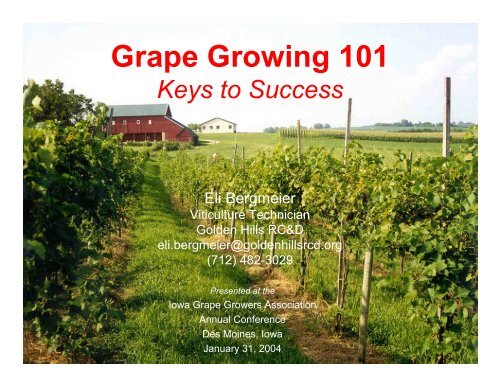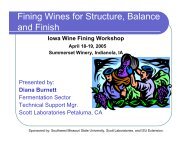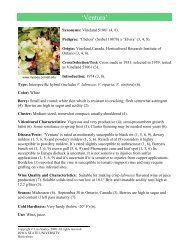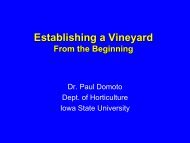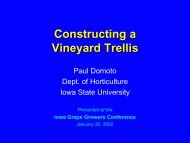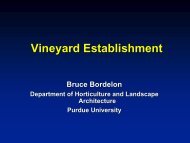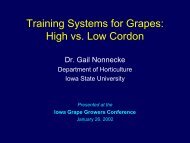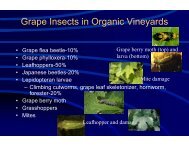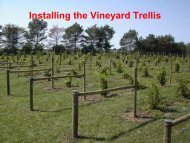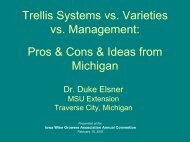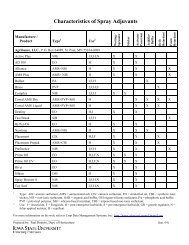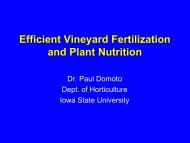Grape Growing 101 - Viticulture Iowa State University
Grape Growing 101 - Viticulture Iowa State University
Grape Growing 101 - Viticulture Iowa State University
Create successful ePaper yourself
Turn your PDF publications into a flip-book with our unique Google optimized e-Paper software.
<strong>Grape</strong> <strong>Growing</strong> <strong>101</strong><br />
Keys to Success<br />
Eli Bergmeier<br />
<strong>Viticulture</strong> Technician<br />
Golden Hills RC&D<br />
eli.bergmeier@goldenhillsrcd.org<br />
(712) 482-3029<br />
Presented at the<br />
<strong>Iowa</strong> <strong>Grape</strong> Growers Association<br />
Annual Conference<br />
Des Moines, <strong>Iowa</strong><br />
January 31, 2004
Essential Success Factors<br />
• Market<br />
• Site Selection<br />
• Cultivar<br />
Selection<br />
• Inputs<br />
– $$$<br />
– Materials<br />
– Management<br />
Photo courtesy Mike White, ISU Extension
Market Potential
Market Potential<br />
• Three primary markets for grapes:<br />
– Wine<br />
• 95+% of the present IA commercial market<br />
• Limited market size<br />
–Juice<br />
– Fresh consumption, jelly, and other food<br />
products<br />
• Over-production will result in reduced<br />
fruit prices or unsold fruit.
Gallons<br />
IA Wine Market<br />
Projected IA Wine Production Vs. 5% and 7.5%<br />
Market Share Values<br />
250000<br />
200000<br />
150000<br />
100000<br />
50000<br />
Reported Wine Production 5% Market Share<br />
7.5% Market Share<br />
0<br />
2002 2003 2004 2005 2006 2007<br />
Year<br />
Justification: reported production figures taken from 28 completed winery surveys submitted to<br />
’03 I.D.A.L.S. Wine Industry Survey. Projected market share values derived by extrapolating<br />
’92-’02 wine excise tax increase rates through ’07 and adding reported IA wine production.
IA Winery Base Preferences<br />
Portion of Annual Production<br />
0.9<br />
0.8<br />
0.7<br />
0.6<br />
0.5<br />
0.4<br />
0.3<br />
0.2<br />
0.1<br />
0<br />
<strong>Iowa</strong> Wine Bases, 2002 - 2007<br />
2002 2003 2004 2005 2006 2007<br />
Year<br />
Estate <strong>Grape</strong><br />
Grower <strong>Grape</strong><br />
IA <strong>Grape</strong><br />
Imported <strong>Grape</strong><br />
<strong>Grape</strong><br />
Fruit/Mead<br />
Justification: figures derived from 28 completed winery surveys submitted to ’03 I.D.A.L.S.<br />
Wine Industry Survey.
IA <strong>Grape</strong> Demand by Wineries<br />
Acres<br />
300<br />
250<br />
200<br />
150<br />
100<br />
50<br />
0<br />
Est. Acres of Bearing IA <strong>Grape</strong>s Needed to Meet Reported<br />
Demand at Various Production Levels<br />
Reported Demand 5% Market Share 7.5% Market Share<br />
2003 2004 2005 2006 2007<br />
Year<br />
Justification: estimated number of bearing grape acres necessary to supply stated IA<br />
wine production levels given wine base preferences reported on 28 completed winery<br />
surveys submitted to ’03 I.D.A.L.S. Wine Industry Survey. Assumes finished wine<br />
yield of 525 gallons per acre.
Acres<br />
Reported IA <strong>Grape</strong> Acres<br />
300.00<br />
250.00<br />
200.00<br />
150.00<br />
100.00<br />
50.00<br />
0.00<br />
Reported Commercial IA Vineyard Acres: Bearing + Unbearing<br />
2002 2003 2004 2005 2006 2007<br />
Year<br />
Justification: figures compiled from 163 completed vineyard surveys submitted<br />
to ’03 I.D.A.L.S. Wine Industry Survey. Assumes no attrition.
Keys to Success<br />
1. Know your market<br />
2. Seek a secure<br />
buyer<br />
– Develop relationships<br />
– Contract?<br />
3. Plant in-demand<br />
cultivars<br />
“Marketing is finding out<br />
what your customer wants<br />
and giving it to them.”<br />
Tim Cohn; consultant
Site Selection
Site Selection Considerations<br />
• Climate<br />
– Macro-climate<br />
– Meso-climate; topography<br />
• Soil characteristics<br />
• Distance from sources of herbicide<br />
drift<br />
• Other concerns:<br />
– Access to irrigation source<br />
– Geometric regularity and plot shape
• Macro-climate<br />
concerns:<br />
influenced by<br />
weather patterns<br />
– Winter low<br />
temperatures<br />
– Average season<br />
length (frost free days)<br />
– <strong>Growing</strong> degree days<br />
– Annual precipitation<br />
Climate<br />
• Meso-climate<br />
concerns: heavily<br />
influenced by<br />
topographic<br />
position
U.S.D.A. Cold Hardiness Zones<br />
Zone 4B<br />
-20 to -25º F<br />
Zone 5A<br />
-15 to -20º F<br />
• Locate the vineyard site in a region that is conducive to<br />
the survival of in-demand cultivars.
IA Frost-free Days<br />
• Minimum frost-free days for commercial cultivars<br />
ripening early - 150 days; early mid-season - 160<br />
days; late mid-season - 170 days. Image courtesy<br />
Dr. Paul Domoto, I.S.U.
IA <strong>Growing</strong> Degree Days<br />
• Sites offering less than 2500 G.D.D. should be<br />
considered unfavorable for grape production. Image<br />
courtesy of Dr. Paul Domoto, I.S.U.
IA Annual Precipitation<br />
• <strong>Iowa</strong>’s climate typically supplies sufficient precipitation to foster successful<br />
grape production. However, seasonal droughts do occur, and soil<br />
characteristics can negatively impact moisture availability. Image courtesy<br />
of Dr. Paul Domoto, I.S.U.
Topographic Position &<br />
Meso-climate<br />
• Favorable sites offer:<br />
– Elevation: to avoid collection of cold air contributing to late<br />
spring, and early fall frosts.<br />
• Situate vineyard ≥ 50 feet above nearby low-lying areas.<br />
– Slope: to facilitate cold air and surface moisture drainage.<br />
• Greater than 1.5% is desirable, but less than 15% is<br />
necessary for safe equipment operation.<br />
– Exposure to sunlight and wind.<br />
• Full exposure to sunlight and air movement is important.<br />
– Aspect<br />
• South commonly preferred, but each orientation offers<br />
assets and liabilities.
Find the Good Sites…
• Favorable sites offer:<br />
Soil<br />
– Adequate depth of uncompacted soil.<br />
• Greater than 2’; 3’ preferred<br />
• Consult County Soil Survey; dig soil pits if in doubt<br />
– Adequate internal drainage.<br />
• <strong>Grape</strong>s generally grow poorly in oxygen-deficient<br />
soil!<br />
• Defined by County Soil Survey as “well drained” or<br />
“moderately well drained.”<br />
• Perform percolation test if in doubt.<br />
– Seasonal high water table lower than 4’; 6’<br />
preferred<br />
• Consult County Soil Survey
Soil, Cont’d<br />
• Favorable sites offer:<br />
– Proper soil pH and adequate nutrient<br />
concentrations.<br />
• Dual depth pre-plant soil analysis for pH, organic<br />
matter, P, K, and Zn concentrations is essential.<br />
• Soil pH between 5.5 and 7.0 is workable for most<br />
cultivars adapted to IA climatic conditions; soil pH<br />
between 6.0 and 6.5 is preferred.<br />
– Moderate to high available water capacity.<br />
– Moderate organic matter levels.<br />
• 1.0 to 4.0% is workable; 2.0 to 3.0% is preferred<br />
– Low harmful nematode populations.<br />
– Lack of herbicide residue; e.g. atrazine.


